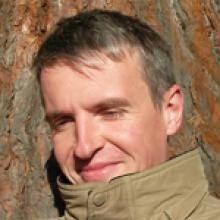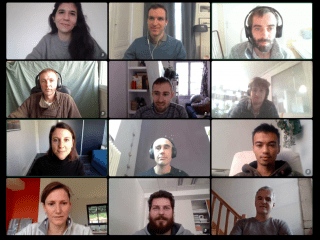The Cocoon Group
Members

Directeur de recherche
CNRS
Tel: 33 04 26 23 44 74

Chargé de recherche
CNRS
Tel: 04 72 43 29 09
Doctorant
UCBL
Tel: 04 72 44 81 42

Directeur de recherche
INRIA
Tel: 33 04 26 23 44 74
Le Cocon is both a research team and a think tank.
Research in “Le Cocon” team focuses on two main topics: multiscale evolution on one hand (i.e., studying the evolution of genetic systems while considering different levels -nucleotides, transposable elements, genes, genomes, microbiomes, organisms, populations, species, geography-), and environmental issues on the other hand. In both cases, we rely on modeling and data analysis, using a combination of statistics and computer science.
Le Cocon is also a place to think about the responsibilities of research and researchers in the anthropocene era, and about the role of non-researcher citizens in orienting and conducting research.
Multiscale evolution
- We have a long history of working on gene transfers. We develop new methods to detect these events in complex systems involving more than two levels (host, symbiont and parasites for example) and
- We use horizontal transfer detection to date species trees and to infer yet unknown biodiversity (extinct and unsampled) (Sthoriz (ANR, 2018)) .
- We have a lasting interest into convergent genomic evolution (Convergenomics - ANR, 2015)
- We question the usual way of testing bioinformatic methods (Evoluthon - ANR, 2019)
- We study the interaction between human populations, their lifestyles, and their gut microbiota (Microregal - ANR, 2015). We are notably interested in identifying cases of host-microbe coevolution and in better understanding transmission dynamics.
Environmental issues
- We develop computational methods to support an agriculture that relies on ecosystemic relationships between crops, the soil, its microbiota, and wild plants and animals (Community Garden Book - Inria, 2019)
- We develop statistical approaches to understand and predict crop yield variability with respect to meteorological conditions
Research in the anthropocene
- We participate to the science shop (UdL), the ethics platform (UdL), Labo1.5, the open science committee, Sciences Citoyennes, the shift project
- We organize a series of seminars to help us think about the position of scientific research in the history of the anthropocene, and about the position of scientists in the future of the anthropocene.
- We assemble committees of citizens to investigate to what extent scientific research can be democratized.
Teaching and outreach
- We teach at University of Lyon, University Lyon 1, INSA, Inria, ENS Lyon, we organize bioinformatics internships
- We regularly participate in the Fête de la Science, have contributed videos in the public transportation system in Lyon, give conferences at Université Populaire and contribute articles in general public journals.
- We develop the software Lifemap to explore the tree of life on computers and smartphones.
Prospective students and postdocs are invited to apply, as we often welcome visitors for internships or research projects.
Publications
Display of 61 to 90 publications on 222 in total
Pitfalls in supermatrix phylogenomics
European Journal of Taxonomy . 283 : 1-25
DOI: 10.5852/ejt.2017.283
Journal article
see the publicationSONIFICATION OF PHYLOGENETIC TREES: LISTENING TO EVOLUTION
Journées d'Informatique Musicale (JIM) 2017 .
Conference paper
see the publicationDeCoSTAR: Reconstructing the ancestral organization of genes or genomes using reconciled phylogenies
Genome Biology and Evolution . 9 ( 5 ) : 1312-1319
DOI: 10.1093/gbe/evx069
Journal article
see the publicationAlgorithms for computing the double cut and join distance on both gene order and intergenic sizes
Algorithms for Molecular Biology . 12 : 16 (11 pages)
Journal article
see the publicationResolution and reconciliation of non-binary gene trees with transfers, duplications and losses
Bioinformatics . 33 ( 7 ) : 980-987
Journal article
see the publicationEcological networks to unravel the routes to horizontal transposon transfers
PLoS Biology . 15 ( 2 ) : np
Journal article
see the publicationAncestral Genome Estimation Reveals the History of Ecological Diversification in Agrobacterium
Genome Biology and Evolution . 9 ( 12 ) : 3413 - 3431
DOI: 10.1093/gbe/evx255
Journal article
see the publicationComparative Methods for Reconstructing Ancient Genome Organization
Comparative Genomics: Methods and Protocols . : 343 - 362
Book chapter
see the publicationMaxTiC: Fast Ranking Of A Phylogenetic Tree By Maximum Time Consistency With Lateral Gene Transfers
DOI: 10.1101/127548
Other publication
see the publicationDating with transfers
Journées Ouvertes Biologie Informatique Mathématiques .
Conference paper
see the publicationAncestral Reconstruction: Theory and Practice
Encyclopedia of Evolutionary Biology . : 70–77
Book chapter
see the publicationHorizontal Gene Transfer and the History of Life
Cold Spring Harbor Perspectives in Biology . 8 ( 4 ) : 1312 - 1319
Journal article
see the publicationNucleotide, gene and genome evolution : a score to bind them all
Journées Ouvertes Biologie Informatique Mathématiques .
Conference paper
see the publicationGenome Rearrangements on both Gene Order and Intergenic Regions
WABI 2016 . 9838 : 162-173
Conference paper
see the publicationFrancisella IglG protein and the DUF4280 proteins: PAAR-like proteins in non-canonical Type VI secretion systems?
Microbial Cell . 3 ( 11 ) : 576-578
Journal article
see the publicationComment la reconstruction de génomes ancestraux peut aider à l'assemblage de génomes actuels
Journées Ouvertes Biologie Informatique Mathématiques .
Conference paper
see the publicationLifemap: Exploring the Entire Tree of Life
PLoS Biology . 14 ( 12 )
Journal article
see the publicationRiboDB database: a comprehensive resource for prokaryotic systematics
Molecular Biology and Evolution . 33 ( 8 ) : 2170--2172
Journal article
see the publicationGene Acquisitions from Bacteria at the Origins of Major Archaeal Clades Are Vastly Overestimated
Molecular Biology and Evolution . 33 ( 2 ) : 305 - 310
Journal article
see the publicationEfficient gene tree correction guided by genome evolution
PLoS ONE . 11 ( 8 ) : e0159559 (22 pages)
Journal article
see the publicationIn silico experimental evolution provides independent and challenging benchmarks for comparative genomics
Journées ouvertes Biologie Informatique Mathématiques . : 79-82
Conference paper
see the publicationComparative Genomics on Artificial Life
Computability in Europe . 9709 : 35-44
Conference paper
see the publicationBreaking Good: Accounting for Fragility of Genomic Regions in Rearrangement Distance Estimation
Genome Biology and Evolution . 8 ( 5 ) : 1427-1439
DOI: 10.1093/gbe/evw083
Journal article
see the publicationSorting Signed Permutations by Reversal (Reversal Sequence)
Encyclopedia of Algorithms . 978-1-4939-2863-7 : 2028-2032
Book chapter
see the publicationGenome rearrangements with indels in intergenes restrict the scenario space
BMC Bioinformatics . 17 ( Suppl 14 ) : 426 (7 pages)
Journal article
see the publicationThe inference of gene trees with species trees
Systematic Biology . 64 ( 1 ) : e42-e62
Journal article
see the publicationReconstruction of an ancestral Yersinia pestis genome and comparison with an ancient sequence
BMC Genomics . 16 ( Suppl 10 ) : S9
Journal article
see the publicationMoments of genome evolution by Double Cut-and-Join
BMC Bioinformatics . 16 ( Suppl 14 ) : S7
Journal article
see the publicationSex and evolution
Handbook of Evolutionary Thinking in the Sciences . 978-94-017-9013-0 : 499--507
Book chapter
see the publicationDegeneration of the Nonrecombining Regions in the Mating-Type Chromosomes of the Anther-Smut Fungi
Molecular Biology and Evolution . 32 ( 4 ) : 928-943
Journal article
see the publication
